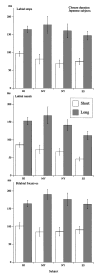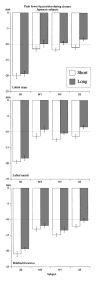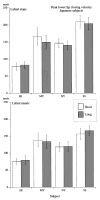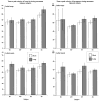Lip kinematics in long and short stop and fricative consonants
- PMID: 15759706
- PMCID: PMC1479427
- DOI: 10.1121/1.1840531
Lip kinematics in long and short stop and fricative consonants
Abstract
This paper examines lip and jaw kinematics in the production of labial stop and fricative consonants where the duration of the oral closure/constriction is varied for linguistic purposes. The subjects were speakers of Japanese and Swedish, two languages that have a contrast between short and long consonants. Lip and jaw movements were recorded using a magnetometer system. Based on earlier work showing that the lips are moving at a high velocity at the oral closure, it was hypothesized that speakers could control closure/constriction duration by varying the position of a virtual target for the lips. According to this hypothesis, the peak vertical position of the lower lip during the oral closure/constriction should be higher for the long than for the short consonants. This would result in the lips staying in contact for a longer period. The results show that this is the case for the Japanese subjects and one Swedish subject who produced non-overlapping distributions of closure/ constriction duration for the two categories. However, the peak velocity of the lower lip raising movement did not differ between the two categories. Thus if the lip movements in speech are controlled by specifying a virtual target, that control must involve variations in both the position and the timing of the target.
Figures
















Similar articles
-
Tongue movement kinematics in long and short Japanese consonants.J Acoust Soc Am. 2007 Jul;122(1):512-18. doi: 10.1121/1.2735102. J Acoust Soc Am. 2007. PMID: 17614508 Free PMC article.
-
Lip and jaw kinematics in bilabial stop consonant production.J Speech Lang Hear Res. 1997 Aug;40(4):877-93. doi: 10.1044/jslhr.4004.877. J Speech Lang Hear Res. 1997. PMID: 9263951
-
Interarticulator programming: effects of closure duration on lip and tongue coordination in Japanese.J Acoust Soc Am. 2006 Nov;120(5 Pt 1):2872-83. doi: 10.1121/1.2345832. J Acoust Soc Am. 2006. PMID: 17139745 Free PMC article.
-
Control of oral closure in lingual stop consonant production.J Acoust Soc Am. 2002 Jun;111(6):2811-27. doi: 10.1121/1.1473636. J Acoust Soc Am. 2002. PMID: 12083216 Free PMC article.
-
Influence of speaking rate on the upper lip, lower lip, and jaw peak velocity sequencing during bilabial closing movements.J Acoust Soc Am. 1991 Feb;89(2):845-9. doi: 10.1121/1.1894645. J Acoust Soc Am. 1991. PMID: 2016434
Cited by
-
Dynamical account of how /b, d, g/ differ from /p, t, k/ in Spanish: Evidence from labials.Lab Phonol. 2011 Oct 1;2(2):423-449. doi: 10.1515/labphon.2011.016. Lab Phonol. 2011. PMID: 23843928 Free PMC article.
-
OroSTIFF: Face-referenced measurement of perioral stiffness in health and disease.J Biomech. 2010 May 28;43(8):1476-82. doi: 10.1016/j.jbiomech.2010.01.037. Epub 2010 Feb 24. J Biomech. 2010. PMID: 20185131 Free PMC article.
-
Vowel-to-vowel coarticulation in Japanese: the effect of consonant duration.J Acoust Soc Am. 2009 Feb;125(2):636-9. doi: 10.1121/1.2973234. J Acoust Soc Am. 2009. PMID: 19206841 Free PMC article.
-
Explaining Coronal Reduction: Prosodic Structure and Articulatory Posture.Phonetica. 2018;75(2):151-181. doi: 10.1159/000481099. Epub 2018 Feb 8. Phonetica. 2018. PMID: 29433121 Free PMC article.
-
Upper Lip Horizontal Line: Characteristics of a Dynamic Facial Line.Int J Environ Res Public Health. 2020 Sep 13;17(18):6672. doi: 10.3390/ijerph17186672. Int J Environ Res Public Health. 2020. PMID: 32933221 Free PMC article.
References
-
- Adams S, Weismer G, Kent R. “Speaking rate and speech movement velocity profiles,”. J Speech Hear Res. 1993;36:41–54. - PubMed
-
- Beckman M. “Segment duration and the mora in Japanese,”. Phonetica. 1982;39:113–135.
-
- Byrd, D. (1995) “Articulatory characteristics of single and blended lingual gestures,” in Proceedings of the XIIIth International Congress of Phonetic Sciences, edited by K. Elenius and P. Branderud, Stockholm, Vol. 2, pp. 438–441.
-
- Byrd, D., Kaun, A., Narayanan, S., and Saltzman, E. (2000) “Phrasal signatures in articulation,” in Papers in Laboratory Phonology V: Acquisition and the Lexicon, edited by M. B. Broe and J. B. Pierrehumbert (Cambridge U.P., Cambridge), pp. 70–87.
-
- Cooke, J. (1980) “The organization of simple, skilled movements,” in Tutorials in Motor Behavior, edited by G. Stelmach and J. Requin (North-Holland, Amsterdam), pp. 199–212.
Publication types
MeSH terms
Grants and funding
LinkOut - more resources
Full Text Sources

